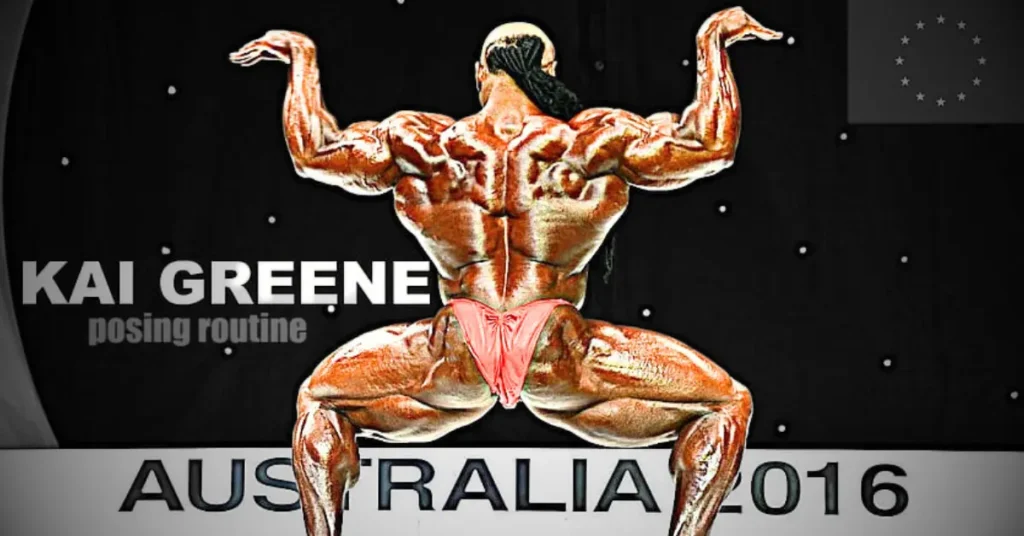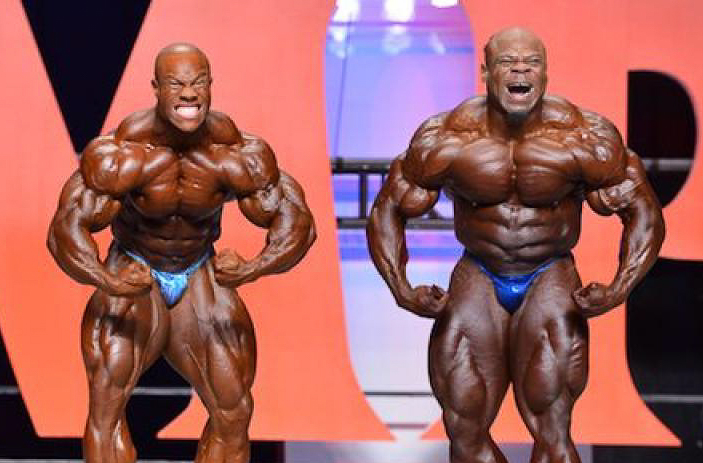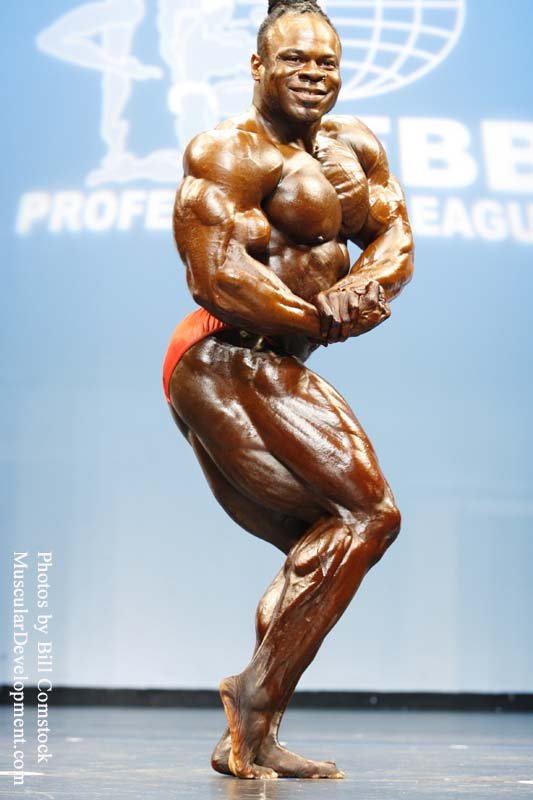In the world of professional bodybuilding, where size, symmetry, and conditioning are paramount, Kai Greene transcended the sport to become something more: a performer, an artist, and a philosopher.
While other bodybuilders focused solely on flexing muscle, Greene turned the posing routine into a theatrical masterpiece—a fusion of movement, emotion, and storytelling.
His most iconic and widely celebrated posing routine, famously known as “The Mantis,” is not just a sequence of mandatory poses. It is a choreographed performance that redefined what it means to present a physique on stage.
Kai Greene’s posing didn’t just showcase his physique.
It revealed his soul.
“The Mantis” is the name he gave to his alter ego—a dark, insectoid warrior symbolizing precision, patience, and predatory focus.
This persona became the foundation of his most famous posing routine, first performed at the 2012 Mr. Olympia and refined in subsequent years.
“The Mantis sees everything. It moves when you don’t expect it.”
Greene’s routine was revolutionary because it:
- Broke the mold of traditional posing
- Integrated music, movement, and facial expression
- Told a story—from stillness to explosion
It wasn’t just about looking big.
It was about feeling powerful.

🎵 The Music: A Soundtrack of Power
Kai Greene’s posing routine was always set to dramatic, cinematic music—often a blend of orchestral scores, tribal rhythms, and electronic beats.
For his 2012 Olympia routine, he used a custom-composed track that built from a slow, haunting melody to a thunderous crescendo—mirroring his transition from calm to chaos.
The music wasn’t background noise.
It was a partner in performance.
“I don’t just pose. I perform.”
🧘♂️ The Posing Sequence: A Breakdown of “The Mantis” Routine
Greene’s routine was a 12-step performance, blending the mandatory poses with original choreography. Here’s how it unfolded:
1. The Stillness (Opening Pose)
- Pose: Side chest (right), frozen in place
- Details: Eyes closed, deep breath, complete control
- Purpose: To command attention through stillness
“Before the storm, there is silence.”
2. The Awakening
- Movement: Slow opening of the eyes, subtle muscle ripple
- Details: Begins with a lat spread, then transitions to front double biceps
- Emotion: Awakening power
3. Front Double Biceps
- Execution: Not just a flex—a slow contraction, starting from the chest and radiating outward
- Signature Move: Holds the peak for 3–4 seconds, then pulses

4. Side Chest (Right & Left)
- Flow: Smooth transition, no jerky movements
- Details: Emphasizes rib cage flare, waist control, and arm fullness
- Facial Expression: Intense, focused
5. Back Double Biceps
- Execution: One of the best in history—lats flare wide, traps rise, glutes contract
- Greene’s Touch: Adds a slow wave through the back muscles, like a ripple
6. Side Triceps (Right & Left)
- Focus: Triceps peak, lat sweep, and leg sweep
- Movement: Controlled turn, then a sharp contraction
7. Most Muscular
- Form: Full-body flex, but with artistic flair
- Greene’s Style: Adds a head tilt and facial snarl, turning it into a beast-like display

8. Abdominals and Thighs
- Execution: Deep knee bend, abs flexed, quads tensed
- Greene’s Flair: Adds a side-to-side sway, showcasing quad sweep and separation
9. The Transition – “The Mantis” Move
- Original Choreography: A slow-motion crouch, arms extended like insect limbs
- Inspiration: Based on the praying mantis, symbolizing precision and strike
- Effect: Audience captivated—this was not bodybuilding. This was theater.
10. The Explosion
- Movement: A sudden, explosive rise into a full lat spread
- Music Sync: Matches the climax of the soundtrack
- Visual Impact: Veins pop, muscles contract, stage lights reflect off dry skin
11. Final Pose: Front Lat Spread
- Hold: Long, sustained, with deep breathing
- Expression: Triumphant, almost spiritual
- Message: “I am complete.”
12. The Exit
- Movement: Slow walk, head high, no rush
- Energy: Leaves the stage still “in character”
🧠 The Philosophy Behind the Performance
Kai Greene didn’t just pose.
He believed.
His routine was rooted in his core philosophy:
“Thoughts Become Things.”
He visualized every contraction, every movement, every emotion months before stepping on stage.
Key Principles:
- Mind-Muscle Connection
- Every flex was felt, not just seen.
- Emotional Intensity
- He didn’t just show muscle—he showed struggle, pain, and triumph.
- Storytelling
- The routine had a beginning, middle, and end—a hero’s journey.
- Uniqueness
- He refused to copy others. “I don’t compete. I express.”
“If you don’t feel it in the muscle, you’re just moving weight.”

🌍 Legacy: How “The Mantis” Changed Bodybuilding
Kai Greene’s posing routine didn’t just win applause.
It changed the sport.
🔹 Before Greene:
- Posing was functional—a way to display muscle
- Routines were predictable, with little variation
- Music was optional, often generic
🔹 After Greene:
- Posing became artistic and emotional
- Athletes began choreographing their routines
- Music, facial expression, and flow became essential
Today, bodybuilders like Chris Bumstead, Hadi Choopan, and Samson Dauda incorporate storytelling and emotion into their routines—inspired by Greene’s legacy.
📽️ Where to Watch It: The 2012 Mr. Olympia Performance
The most famous version of “The Mantis” routine was performed at the 2012 Mr. Olympia, where Greene placed 2nd to Phil Heath.
You can watch it on:
- YouTube: Search “Kai Greene 2012 Olympia Posing Routine”
- Generation Iron documentaries
- IFBB Official Archives
The video has over 10 million views and is considered one of the greatest posing routines in history.
💬 Fan Reactions & Judge Feedback
- Fans: Called it “a religious experience,” “bodybuilding as art,” “the greatest performance ever.”
- Judges: Praised his stage presence, control, and originality—though some felt his size wasn’t quite enough to win.
- Critics: Said it was “too theatrical”—but even they admitted it was unforgettable.
“I’ve seen thousands of routines. But Kai’s? That one stays with you.”
— Anonymous IFBB Judge
🔥 Final Thoughts: The Man Who Posed Like No Other
Kai Greene never won the Mr. Olympia title.
But in the minds of millions, he won something greater.
He won the title of the most expressive, artistic, and unforgettable bodybuilder of his era.
His “Mantis” posing routine wasn’t just a display of muscle.
It was a manifestation of his journey—from a foster child in Brooklyn to a global icon.
It was pain transformed into power.
And to this day, when bodybuilders step on stage and pause, breathe, and flex with intention, they are channeling the spirit of Kai Greene.
Because he didn’t just pose.
He performed.
And in doing so, he elevated the entire sport.
